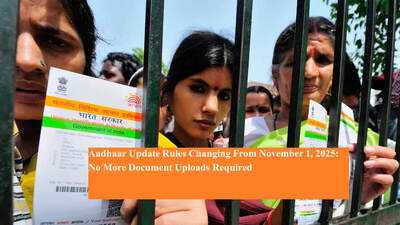Aadhaar Update New Rules: The Unique Identification Authority of India (UIDAI) has announced a major change in the Aadhaar update process. Starting November 1, 2025, Aadhaar cardholders will be able to update their name, address, date of birth, and mobile number online — without uploading any supporting documents.
The update process will now be fully online, automatic, and paperless, as UIDAI will verify user details through other government databases such as PAN, Passport, Driving Licence, Ration Card, Birth Certificate, and School Records.
🔹 Revised Aadhaar Update Fees (Effective October 1, 2025)UIDAI has also revised the Aadhaar update charges. Here are the new rates:
-
Demographic Update (₹75): For changing name, address, date of birth, mobile number, or email ID (previously ₹50)
-
Biometric Update (₹125): For updating fingerprints, iris, or photograph (previously ₹100)
-
Free Updates for Children:
-
Biometric updates are free once for children aged 5–7 years and 15–17 years
-
For children aged 7–15 years, free updates are allowed until September 2026
-
-
Document Update: ₹75 at Aadhaar centres, but free online till June 2026
The government has reiterated that linking PAN with Aadhaar is mandatory by December 31, 2025.
Failure to do so will result in PAN deactivation from January 1, 2026, which may affect:
-
Income Tax filing
-
Mutual Fund and Demat accounts
-
Tax-saving investments
UIDAI and NPCI have rolled out new facilities like Offline KYC and Aadhaar e-KYC Setu, allowing banks and NBFCs to verify customer identity without collecting the full Aadhaar number.
This not only strengthens data privacy but also makes account opening and verification faster.
Only active and non-duplicate Aadhaar numbers will now be valid for KYC.
If your Aadhaar is found invalid or duplicated, your bank account or investment verification may be suspended.
UIDAI advises users to regularly check their Aadhaar status on the UIDAI website or the mAadhaar app.
🔹 Changes in AePS and Small Savings AccountsFrom January 1, 2026, new KYC and fraud-monitoring rules will apply to the Aadhaar Enabled Payment System (AePS).
-
Rural cash withdrawals and deposits may have limited access, but the move aims to reduce fraud.
-
Post Office schemes like RD, PPF, and NSC can now be opened through Aadhaar e-KYC.
-
If your Aadhaar is not linked or outdated, deposits and withdrawals may be temporarily blocked.
UIDAI is developing a secure offline system where users can show their Aadhaar QR code or masked ID instead of sharing full details.
This will enhance security and user privacy during KYC processes at banks or financial institutions.
-
Aadhaar holders can update name, address, date of birth, and mobile number online
-
No document upload will be required
-
UIDAI will automatically verify data from linked government databases
-
Only biometric updates (fingerprints/iris scans) will require visiting an Aadhaar centre
Check your Aadhaar status on the UIDAI website or mAadhaar app
Verify PAN–Aadhaar linking on the Income Tax portal
Update Aadhaar details with your bank and investment accounts
Rural users should check the latest AePS rules with local banks or Aadhaar centres
Keep Aadhaar-linked KYC details updated regularly to avoid disruptions
With these changes, Aadhaar management is becoming faster, safer, and completely paperless — ensuring smoother access to financial and government services for millions of users across India.
You may also like

'Laid down arms in line with Basavaraj's call': Maoist Rupesh rejects 'traitor' tag; explains reason for surrender

Uttarakhand announces implementation of Green Cess on vehicles from other states on its 25th anniversary

Lewis Hamilton hit with big Mexico GP penalty after leaving Max Verstappen furious

Putin puppet makes chilling 'nuclear weapons' suggestion in rage over Trump sanctions

Chemistry Nobel Prize winner Susumu Kitagawa reveals Japanese research mindset: 'Don't switch off the light, even…'







